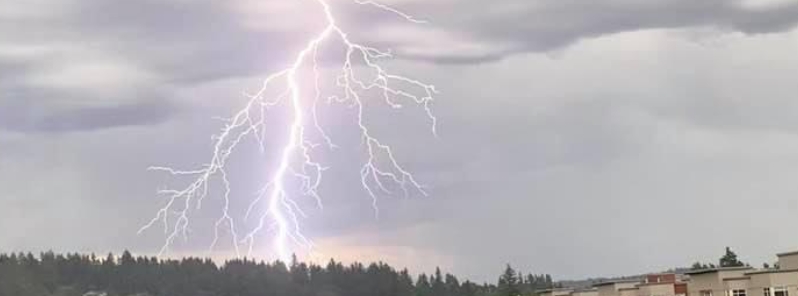Nearly 87 000 lightning strikes detected during ‘once in a decade storm’ in Washington state, U.S.

Up to 86 714 lightning strikes were recorded in the entire Washington state, U.S., on Saturday, May 30, 2020– about 62 percent of the state's yearly lightning average. It occurred during a severe weather event described by the National Weather Service (NWS) as a "once in a decade" storm.
Multiple waves of thunderstorms barreled through the state over the weekend, bringing wind gusts and hail that tore down numerous trees.
In Western Washington, the National Lightning Detection Network registered 15 755 lightning strikes, 4 119 of which struck the ground, while the rest were within the clouds, according to meteorologist Chris Vagasky with Vaisala.
The first wave of thunderstorms hit the Interstate-5, prompting rare Severe Thunderstorm Warnings. Two lightning strikes even caused some trees to explode in Kirkland and Woodinville.
"I could tell it was close because the whole house shook and I could hear what sounded like a crack," a resident said. "Then a piece of wood came flying into our yard."
A second round of intese thunderstorms moved into Central and Eastern Washington Saturday evening, accompanied by wind gusts of 97 to 113 km/h (60 to 70 mph), as well as large hail.
Several trees were downed in Prosser, Union Gap, and Wenatchee, with gusts of 97 km/h (60 mph) reported in Pullman and 93 km/h (58 mph) in Spokane.
Check out this lighting strike off Woodinville -Duvall Road. Remember to stay inside during lighting storms #wawx pic.twitter.com/Fr95nzoqGd
— Woodinville Fire (@WoodinvilleFire) May 31, 2020
This was the biggest burst I’ve ever seen. Big hail! @ScottSKOMO @ShannonODKOMO @KSeattleWeather @weatherchaser5 @WestSeaWx pic.twitter.com/knDn4x9hpc
— Rob Nelson (@Robthegman) May 30, 2020
ANOTHER ANGLE: New home video of the lightning strike that exploded a tree in Kirkland this morning. You can see it raining tree bits! #wawx
Video courtesy: Rob KachmanSTORM UPDATES: https://t.co/V7IpMGUe6g pic.twitter.com/e8fs6NiCjr
— Scott Sistek (@ScottSKOMO) May 30, 2020
The dangers of lightning! This tree exploded after being hit in Kirkland, sending debris across the neighborhood and causing some damage to a home four houses away from the strike! #WAwx
UPDATES HERE: https://t.co/V7IpMHbPuQ pic.twitter.com/oHsb0r2X44
— Scott Sistek (@ScottSKOMO) May 30, 2020
Vagasky noted that 86 714 lightning strikes were detected statewide, which is about 62 percent of the state's yearly lightning average. The number was also more than the total lightning the area received in 2006, which was 82 710 strikes.
It was the second year in a row that the state has been pounded by hundreds of thousands of lightning. In 2019, more than 250 000 lightning strikes hit the state.
Vagasky added that Oregon recorded 32 925 strikes — or about 11 percent of the state's annual average. With two states combined, the 119 639 strikes made about 25 percent of the region's yearl average.
"The annual average for Washington and Oregon is 439 635, so 27.2 percent of the annual lightning occurred in just 0.27 percent of the year," he said.
Just how anomalous was the weather in #WAwx and #ORwx yesterday? Well…The NLDN detected 119,639 total #lightning events across the two states yesterday. The annual average for Washington + Oregon is 439,635, so 27.2% of the annual lightning occurred in just 0.27% of the year! pic.twitter.com/zUG8e1CAWN
— Ch☈is Vagas|☇y (@COweatherman) May 31, 2020
For #ORwx, a total of 32,925 #lightning events were detected by the National Lightning Detection Network. This is 11% of the annual average and 7.5% of what was detected last year (438,082). @civilsurfer1 @KelleyKOIN @MarisaWoloszyn pic.twitter.com/OgnwAKn8lZ
— Ch☈is Vagas|☇y (@COweatherman) May 31, 2020
On Sunday, May 31, the NWS Spokane described the storm as a once in a decade storm. "This is a serious event! Something we haven't seen in our area for probably 10 years or longer."
The forecast shows that it will be sunny and cloudy until Thursday, June 2, but there will be chances of rain from Friday night into Saturday, June 5 to 6.
Lightning captured from Boeing Field #komonews #wawx @ScottSKOMO pic.twitter.com/FnQiDRjSqy
— Matt Markovich (@mattmarkovich) May 30, 2020
Lightning from Redmond this morning caught on camera by Eva Seydl. Thunderstorms still moving northward across the Sound at this hour. Remember…if you see a flash, dash inside! #wawx pic.twitter.com/BmM3vFlGhF
— NWS Seattle (@NWSSeattle) May 30, 2020
Featured image credit: Eva Seydl/NWS Seattle

It abundantly clear that lightning strikes have increased around the globe and the reason is not man-made climate change, as mainstream science is claiming. The increase is exclusively, due to the massive increase of cosmic radiation. It is worth mentioning, that mainstream scientists started to acknowledge that lightning is the main cause about most of the wildfires, but of course they still do not acknowledge that lightning is triggered by Cosmic Rays. Lightning strikes have increased enormously in 2019 and records were shattered around the globe. 210,000 lightning strikes were recorded in Sweden in 2019, a six-fold increase on 2017. And, in New Zealand, 300,000 lightning strikes were recorded on Sunday December 8th of 2019, and 872,000 over the entire weekend. It seems that in 2020 the records will be broken again
Thank you for the perspective. I was just thinking this would explain the unusual bursts in the Schumann resonance. Since S.r is said to be powered by lightning strikes.